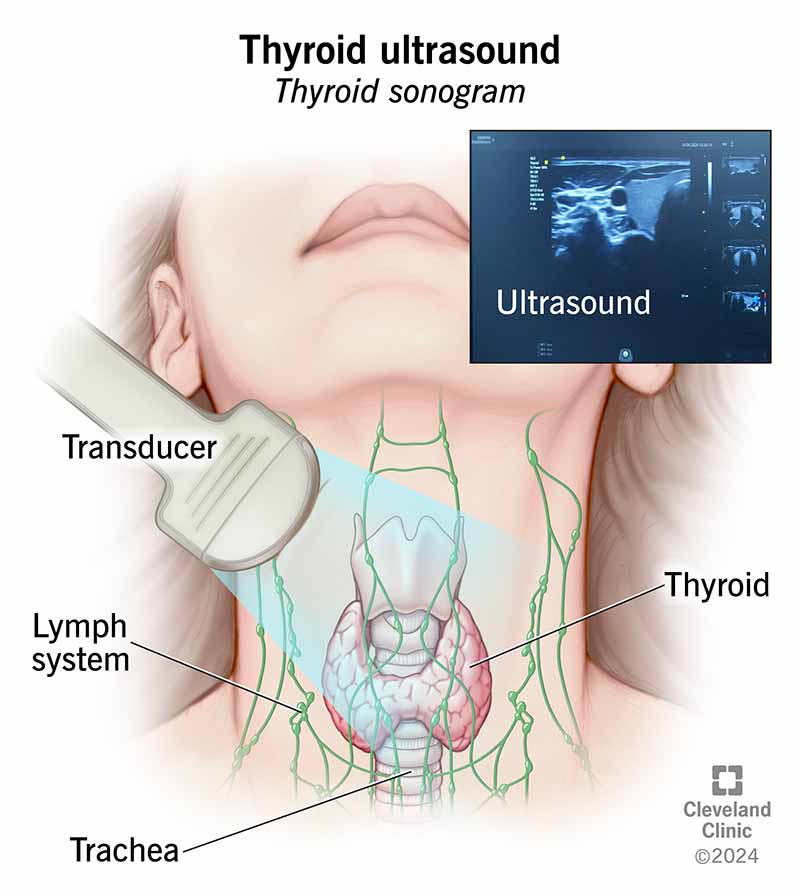A thyroid ultrasound is a quick, painless imaging test. It lets your provider see your thyroid in real time. They’ll be able to see its size, shape an inflammation. It’s a common test to help providers diagnose lots of conditions that can affect your thyroid. There’s no special prep and no side effects. You might not even need separate appointment.
Advertisement
Cleveland Clinic is a non-profit academic medical center. Advertising on our site helps support our mission. We do not endorse non-Cleveland Clinic products or services. Policy

A thyroid ultrasound is a painless imaging test that lets your provider look at your thyroid and the tissue around it in your neck. Healthcare providers sometimes call a thyroid ultrasound a sonogram or echogram.
Advertisement
Cleveland Clinic is a non-profit academic medical center. Advertising on our site helps support our mission. We do not endorse non-Cleveland Clinic products or services. Policy
Thyroid ultrasounds are the most common thyroid imaging tests. They can help diagnose:
Most of the time, your provider will order a thyroid ultrasound as a follow-up test. For example, you might need one if:
Your provider might also order an ultrasound after feeling your thyroid during a physical exam. But this is less common.
If your provider sees something unusual during an ultrasound, they’ll suggest other tests or treatments.
Ultrasounds use sound waves to show organs and tissue inside your body. The ultrasound machine bounces sound waves off your thyroid. It lets your provider see real-time pictures and/or video of what’s going on under your skin.
Thyroid ultrasounds work well because your provider can easily reach your thyroid. Your thyroid is only around an inch and a half under the skin of your neck. That makes it easy to scan your thyroid with the ultrasound machine’s handheld wand (transducer).
Advertisement
There’s no special prep you need to do before a thyroid ultrasound. Your provider might even be able to do the test right away if they feel something they want to examine during your checkup.
If you do need to make a separate test appointment, you won’t need to change anything in your daily routine. You can eat, drink and take all your usual medications the day of your ultrasound.
Your provider will need access to your neck during a thyroid ultrasound. So, you might want to wear loose, comfortable clothing and avoid wearing any neck jewelry you can’t easily remove.
A thyroid ultrasound is quick and easy. It involves a few steps:
Thyroid ultrasounds usually take around 30 minutes from start to finish. How long your test lasts can vary. It depends on what your provider is looking for and how many photos of your thyroid they need.
There are no risks or side effects of having a thyroid ultrasound. The sound waves your provider uses during the test are harmless. You won’t hear or feel them, and they can’t damage your body.
The test gel might feel cold, especially at first. But it’s nontoxic and won’t hurt your skin.
A thyroid ultrasound will show your thyroid and any growths or changes around it. Your provider will be able to see if your thyroid is larger than usual.
Your provider will tell you if the results of your thyroid ultrasound are normal or abnormal.
A normal result means that everything around your thyroid looks like it should. There was nothing out of place, and your thyroid was its usual size.
Abnormal thyroid ultrasound results mean your provider saw something out of the ordinary. That doesn’t automatically mean your provider found a serious red flag. It just suggests that they need to check on something. Some abnormal results can include:
Advertisement
You might see a TI-RADS score in your test results. This helps doctors classify thyroid nodules and determine what to do next.
Your provider will help you understand your test results. They’ll tell you what to expect, including any other tests or treatments you’ll need.
A thyroid ultrasound can’t diagnose cancer. But it will show your provider if there are new or changing growths on your thyroid. Your provider will suggest other tests, including a thyroid biopsy. You might need a biopsy if your ultrasound shows anything that might be thyroid cancer.
Call your provider if you notice any pain or changes in your neck. Let your provider know if you can see swelling around your thyroid.
Other signs of a thyroid condition might include:
The cold gel swabbed onto your neck should be the hardest part of having a thyroid ultrasound. It’s a quick, painless test. And it can help your provider diagnose lots of different issues that can affect your thyroid.
There are no risks, side effects or complications from having a thyroid ultrasound. Even if you do need to wipe some goo off afterward. If you end up needing more tests or treatments, your provider will help you feel confident and comfortable with what comes next.
Advertisement
Cleveland Clinic’s experienced healthcare providers treat all kinds of thyroid disorders, including issues that cause hypothyroidism and hyperthyroidism.

Last reviewed on 05/05/2025.
Learn more about the Health Library and our editorial process.